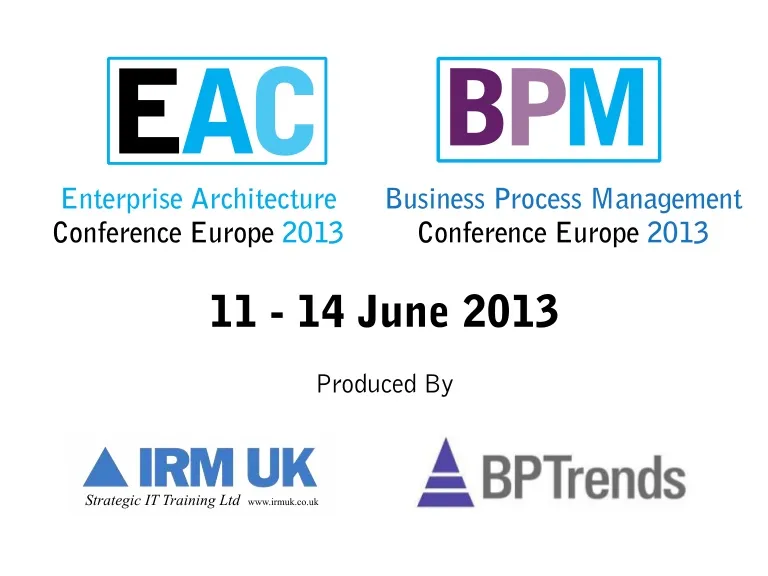Efficient Use of BPMN: Principles, Practices, and Patterns
Description
This is a set of slides that was used at BPM Europe 2013 for a half day workshop on this topic. Please note that an essential part of the workshop was practical assignment on mapping textual description of a business process Recruit New Employee to BPMN business process in two levels of detail. The practical assignment is not a part of this presentation.
Transcript
Efficient Use of BPMNPrinciples, Practices, and Patterns2 About InstructorDr. Darius Šilingas, darius.silingas@nomagic.com Principal Consultant and Head of SolutionsDepartment at No Magic Europe Expert in software, systems and businessmodeling, delivered ~200 training / consultingsessions in 20 countries Head of BPM module of Master in Managementstudies at ISM Executive School Organizer of annual conference BPM in Practice inLithuania3 IntroductionPrinciplesPracticesPatternsWrap up Business Process Modeling: State of the Practice− Business process modeling practice is not yet mature− Modelers create complex and inconsistent businessprocess diagrams that are not accepted by stakeholders5 Anti Pattern: Informal Drawings with Non-Standard NotationHow to optimizethe service timefor the VIPcustomers?6 Business Process Modeling: Advancing State of the Practice+ Use modeling standards+ Establish a set of principles for efficient modeling+ Apply modeling best practices+ Reuse business process patterns7 BPMN – the Standard for Business Process Modeling Business Process Model and Notation (BPMN) is known as defacto standard for graphical business modeling For basic modeling about 20 BPMN elements are sufficient 1 day of training is enough to learn BPMN basics8 IntroductionPrinciplesPracticesPatternsWrap up A Primary Set of Principles for Efficient BPMN1. Unified Business Process Understanding2. A Minimal Subset of BPMN Elements3. Strict Naming Conventions4. Simple Business Process Diagrams5. Appropriate Abstraction10 Unified Business Process UnderstandingBusiness Process is a reusable set of related activities,which is performed by an organization in order to createbusiness value (product, service, document) leadingtowards achieving organization’s business goals.Can you define... a clear beginning?... a clear end?... the business value process brings?… a set of composing activities?… a reusable sequence of activities?Examples: Provide Loan Fulfill Order Organize Conference Prepare Annual Budget Handle Incident Report Perform Financial Audit Recruit New Employee11 A Minimal Subset of BPMN Elements12 Strict Naming Conventions Participant: a noun, e.g. Delegate, Seminar Coordinator Activities: a strong verb + a noun, e.g. Announce Seminar Events: a noun, e.g. Registration Request, Registration Deadline Data objects: a noun, e.g. Customer List, Feedback Form Gateways: unnamed (!) – gateways do not perform work Sequence Flow: named only after a data-based gateway,gives a condition on which it is activated, e.g. Participants > 3013Languageinfluencesthinking Simple Business Process Diagrams – Multiple Levels of DetailRule: up to 10 activities in asingle diagramQuestion: How many taskscan we define in 3 levels ofdetail?14 Appropriate Abstraction“All models are wrong but some are useful.”W. Edwards Demming15 IntroductionPrinciplesPracticesPatternsWrap up Throwaway ModelingBusiness processes are modelled for short-term usage Typically for scoping change in business improvement projectsA particular aspect is emphasized Automation, data exchange, task durations, waste, etc.Process consistency and completeness is not the main concern Apply simplest tools Do not forget to throw away the model!17 Sustainable Modeling• Business process model is a corporate asset that provides along-term value and needs to be maintained and evolved Strict adherence to the principles is necessary A need for a real process modeling tool18 Practices for Sustainable Business Process Modeling1. Model Ownership2. Collaborative Modeling3. Model Review19 Model Ownership• Each business process is assigned to an owner, who isresponsible for creating and maintaining its model (incollaboration with process stakeholders) Gives a clear contact point for process improvements Enables business process model sustainability20 Collaborative Modeling• Business process modeling is a tool for improvingcommunication and collaboration Modeling needs to be performed in teams Certain techniques like pair modeling can be applied21 Model Review• A quality of model needs to be assessed on a regular basis Review by subject matter experts focuses on the content Review by modeling mentor focuses on the form Enables high-quality and sustainable models Helps to improve modeling skills22 IntroductionPrinciplesPracticesPatternsWrap up Pattern #1: Deferred Choice25 Pattern #2: Internal Business Error26Handle Offer Request Anti Pattern: Repeating Event27 Pattern #3: Interruptible Subprocess28 Some Business Process Blueprints in BPMN1. Reservation2. Competition3. Consolidation29 Blueprint #1: Reservation30 Blueprint #2: Competition31Collect Proposals Blueprint #3: Consolidation32 IntroductionPrinciplesPracticesPatternsWrap up Building Sustainable Business Modeling Culture Use business modeling standards like BPMN Stick to a set of principles for efficient modeling Apply best practices for modeling, models usage &management Learn and apply business process patterns and blueprintsImproving business models is a never ending journey...34 Modeling Culture35ModelingModelUsageModelGovernanceHigh Value from Modeling and ModelsCenter ofExcellence Principles think BIGstart SMALLand EVOLVEThe Recipe for Success36 The Truth is inthe Models37® The EndThank you for attention!Any questions???Recommended Reading:• Refactoring BPMN Models: From Bad Smells to BestPractices and Process Patterns (in BPMN 2.0 Handbook)• BPMN articles at www.modernanalyst.comLet’s Keep in Touch e-mail: darius.silingas@nomagic.com Skype: darius.silingas Twitter: dariussilingas LinkedIn: http://lt.linkedin.com/in/dariussilingas38
